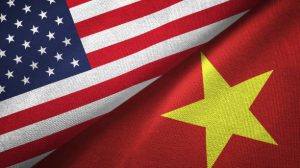
Almost half a century has passed, yet the riddle still persists. As the years go by its importance, far from diminishing, seems to grow. So much so that many people throughout the globe now look at what took place on 30 April 1973 as a historical turning point. One at which the decline of a superpower that used to dominate the globe began.
*
By way of an excuse, they apparently fabricated an attack on one of their destroyers (the Maddox) that never took place.
They had a population of 200,000,000; the other side only had about one tenth of that number.
They were world famous for their efficiency and “can do” attitude; the other side was supposed to be backward, lazy and slow.
They were history’s wealthiest nation by far; the other side was an impoverished “developing” country. Translated into per capita GDP, the economic gap may have been about thirty to one.
They were the world’s most industrialized country by far; the other side, having barely emerged from colonial rule, had hardly any industry at all.
In country, they and their local allies outnumbered the other side by about three to one.
They had absolute command of the sea; a few antiquated torpedo boats apart, the other side had no navy of any kind.
They had the world’s largest and most sophisticated logistic system, one fully capable of supporting 650,000 men (hardly any women yet) across the largest ocean on earth, transporting a quarter million tons of cargo a month, no less. The other side relied on bicycles, sampans (which could only carry their loads if they were carefully concealed), and human porters. To be fair, it also had some trucks. Though certainly not nearly as many as its enemy did.
For communication they used the most modern equipment available at the time: including transistors (which had recently replaced vacuum tubes), satellites, topographic scatter, and VHF. The other side had nothing like it; especially during the early phases of the conflict, they were more likely to rely on underage runners.
They had the world’s most powerful air force and used it to drop three times as many bombs as were dropped on Germany and Japan together during World War II. Still not content, they used defoliants with which to devastate entire districts so as to deny the other side cover. Whereas the other side barely had an air force at all; throughout the years that the conflict lasted, they did not drop a single bomb on their enemy on the ground.
They could reach, attack and demolish every square inch of the other side’s territory; that side’s ability to do the same was exactly zero.
They had tanks, artillery, armored personnel carriers, and vast fleets of vehicles of every kind. The other side only got some of these things towards the end of the conflict, long after its outcome had been decided.
Mainly relying on helicopters, their MEDEVAC (medical evacuation) system was the best in history; as a result, far fewer of their troops who were wounded died. The other side never had a single helicopter.
Wherever their troops went, they enjoyed creature comforts of every kind, from beer to ice cream; whereas the other side walked about in black pajamas and sandals cut out of discarded tires.
In the whole of history, a more asymmetrical conflict would be hard to find. They won every engagement, yet still managed to lose—in the most humiliating possible way. With the last remaining troops clinging to their helicopters’ skids.
*
The more I think about it, the more I wonder. How on earth did they do it? What does it say about them? What does it say about the other side?
Honestly, I do not know.
